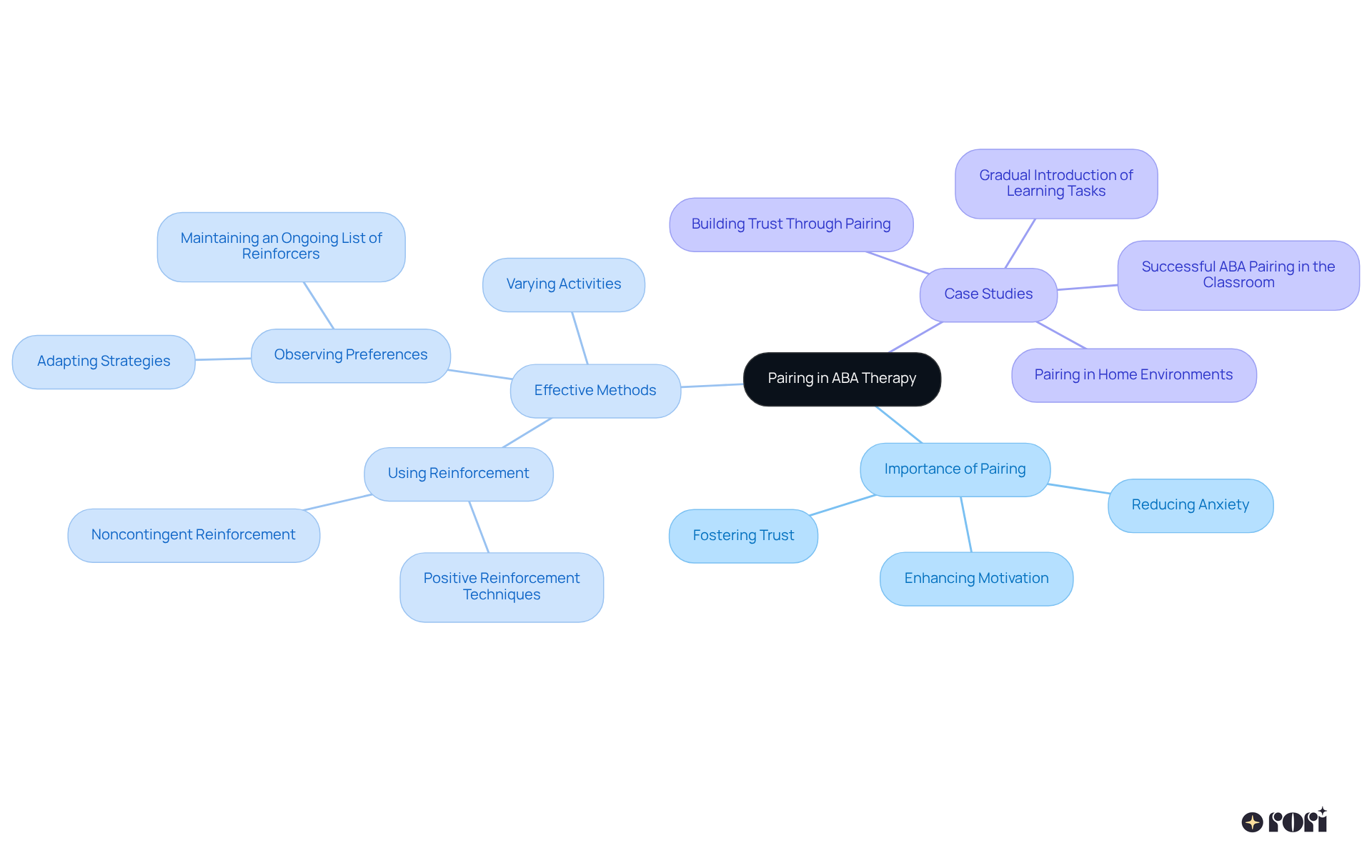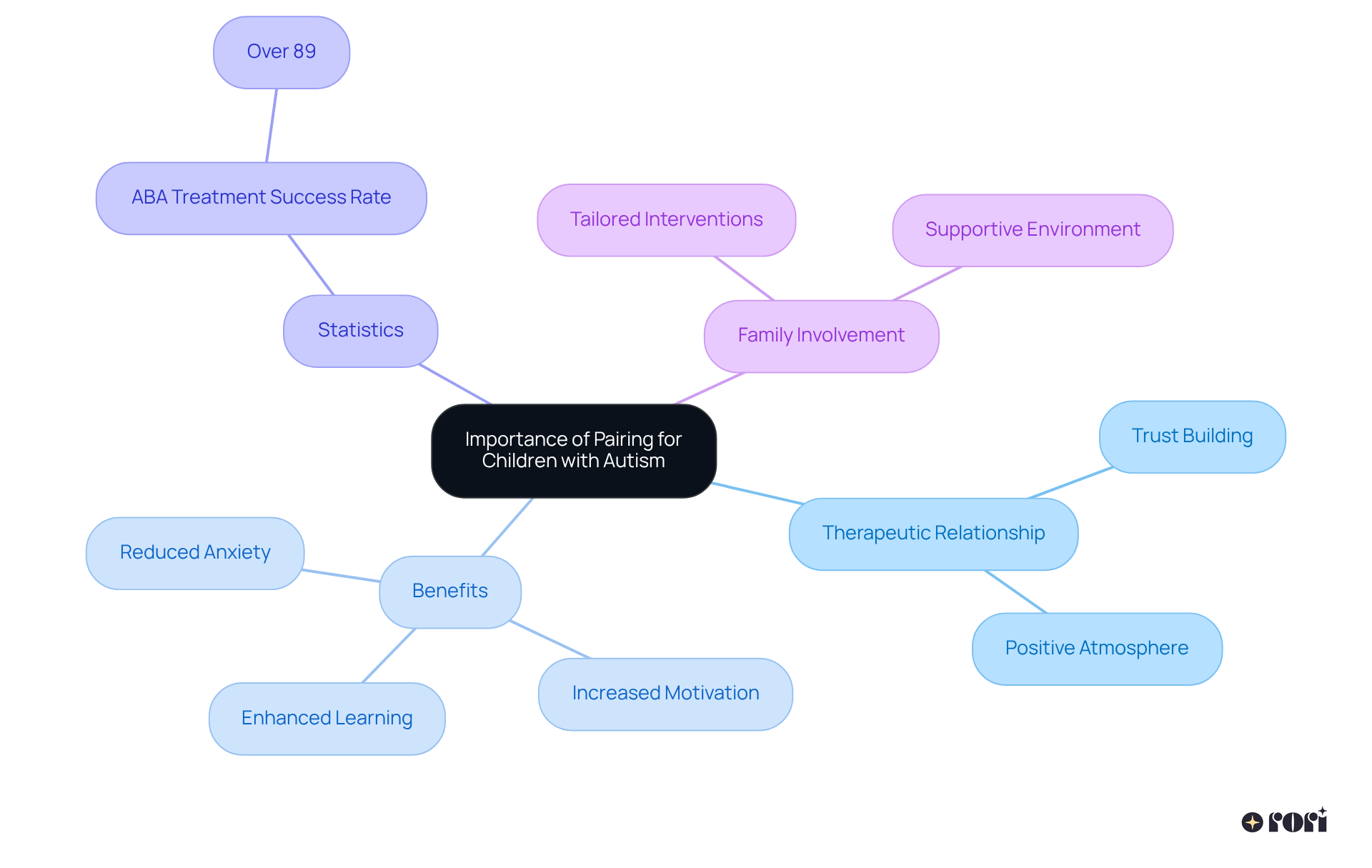Pairing in Applied Behavior Analysis (ABA) therapy is so important for building a positive and supportive relationship between therapists and individuals with autism. This connection really helps boost motivation and ease anxiety during therapy sessions. 🌟
The article highlights some effective pairing techniques, like using preferred activities and having non-demand interactions. These approaches can significantly enhance engagement and outcomes in therapy, creating a comfortable environment that encourages learning and positive behavioral change. Let’s explore this together!
Understanding the dynamics of Applied Behavior Analysis (ABA) therapy reveals a fascinating technique known as pairing. This method plays a pivotal role in fostering positive relationships between practitioners and children with autism. Not only does it enhance motivation and engagement during therapy sessions, but it also significantly reduces anxiety. This creates an environment where young individuals feel safe to explore new skills.
But what happens when the bonds formed through pairing are tested? Can the very techniques that promote trust adapt to meet the unique challenges faced by each child? Let’s dive into the nuances of pairing in ABA therapy together! This article explores its importance, techniques, and the transformative impact it can have on the therapeutic journey for children with autism. We’re here to help you every step of the way!
Understanding what is pairing ABA in the context of Applied Behavior Analysis (ABA) intervention is such an important process! It helps create a positive and reinforcing bond between the practitioner and the young individual. This technique connects the practitioner with enjoyable activities or preferred items, fostering a sense of trust and comfort.
When these positive connections are formed, the therapist becomes a source of enjoyable experiences. This significantly boosts the young person's motivation to participate in therapy. Studies show that successful combinations not only lessen anxiety but also enhance the young person's eagerness to engage in learning activities, promoting behavioral change.
Effective matching methods involve:
Case studies highlight that when therapists focus on establishing rapport through enjoyable interactions, young individuals are more open to learning. This leads to enhanced outcomes in their therapy journey.
Ultimately, understanding what is pairing ABA lays the groundwork for a strong therapeutic alliance, which is crucial for effective learning and development in individuals with autism. Let’s explore this together and see how these connections can make a difference!

Pairing is so important for kids with autism because it lays the groundwork for a successful therapeutic relationship. By creating a positive, trust-filled atmosphere, pairing helps reduce anxiety and resistance that young individuals may feel towards therapy. When kids associate their therapist with enjoyable experiences, they’re more likely to jump into sessions with enthusiasm. This boost in motivation not only enhances learning but also fosters a sense of safety, allowing youngsters to explore new skills and behaviors in a nurturing environment.
Research shows that effective pairings can lead to significant improvements in communication, social skills, and overall developmental progress. For instance, ABA treatment boasts an impressive over 89% success rate in addressing autism spectrum disorder in young individuals, highlighting the effectiveness of this approach. Plus, case studies reveal that kids who engage in pairing before treatment sessions tend to show fewer negative vocalizations and are more ready to participate. Just think about a study that looked at a 4-year-old's response to these collaborative procedures!
Ultimately, effective pairing—a concept that encompasses what is pairing aba, defined as a method to build rapport with clients through the delivery of preferred tangible and/or edible rewards, attention, and activities without demands—is crucial for maximizing the therapeutic benefits for children with autism. And let’s not forget, involving family in the treatment process enhances the effectiveness of these pairings, ensuring that interventions are tailored to meet each individual's unique needs. Let’s explore this together and see how we can make a difference for your child!

Understanding what is pairing aba is essential for implementing effective pairing methods in ABA practice, which are crucial for creating a positive therapeutic environment! Here are some key strategies to consider:
Identifying Preferred Activities: Take some time to observe and engage with your little one to discover their favorite toys, games, or activities. Understanding what they love helps you weave these preferences into therapy sessions, making them more enjoyable. Did you know that kids who receive at least 25 hours of ABA therapy each week tend to see better outcomes? It really shows how important it is for them to be involved in their therapy!
Non-Demand Interactions: At the start, focus on fun activities without placing any demands on your child. This approach creates a relaxed atmosphere, helping them feel safe and comfortable, which is so crucial for effective learning. Research has shown that kids who are exposed to social narratives often show positive behavior changes, highlighting just how impactful these non-demand interactions can be.
Gradual Introduction of Demands: Once you’ve built a good rapport, it’s time to gently introduce some tasks or demands. Just remember to connect these tasks with positive reinforcement, so your child associates them with enjoyable experiences. A meta-analysis found that children in ABA treatment often improve in their communication and language skills, reinforcing the idea that a gradual approach works wonders.
Consistent Reinforcement: Offering consistent positive reinforcement during your interactions strengthens the bond between you and your child. This reinforcement is key to keeping their motivation high and their involvement strong throughout the therapy process. Research indicates that ABA intervention has a success rate of over 89% in enhancing skills among youth with autism, emphasizing the importance of effective reinforcement strategies.
By using these methods, you can build a strong connection with your child, which is essential for understanding what is pairing aba and enhancing the overall effectiveness of ABA intervention. Plus, don’t forget that parental involvement is crucial! Families play a vital role in supporting their child's therapy journey, leading to meaningful progress in outcomes. Let’s explore this together!

Understanding the concept of pairing in Applied Behavior Analysis (ABA) is fundamental to fostering effective therapy for children with autism. This technique emphasizes creating positive associations between the therapist and enjoyable experiences. Not only does this alleviate anxiety, but it also enhances motivation and engagement during therapy sessions. By establishing a strong therapeutic alliance, pairing becomes a cornerstone for successful learning and development.
Let’s dive into why pairing is so important! It plays a crucial role in:
Think about identifying preferred activities, implementing non-demand interactions, and ensuring consistent reinforcement—these techniques are vital for maximizing the benefits of pairing. Plus, involving families in the therapeutic process really amplifies the effectiveness of these strategies, tailoring interventions to meet each child's unique needs.
Ultimately, we can’t overstate the significance of pairing in ABA therapy. By prioritizing enjoyable interactions and building trust, practitioners can create an environment that’s truly conducive to learning and growth. This approach empowers children with autism to thrive in therapy and encourages families to actively participate in their child's journey. Embracing these techniques and insights can lead to transformative outcomes, making a profound difference in the lives of young individuals and their families. So, let’s explore this together—your involvement is key to your child’s success!
What is pairing in ABA therapy?
Pairing in ABA therapy refers to the process of creating a positive and reinforcing bond between the practitioner and the young individual by connecting the therapist with enjoyable activities or preferred items.
Why is pairing important in ABA therapy?
Pairing is important because it fosters trust and comfort, boosts motivation to participate in therapy, reduces anxiety, and enhances eagerness to engage in learning activities, promoting behavioral change.
What methods are effective for pairing in ABA therapy?
Effective methods for pairing include using prompt and steady reinforcement, varying activities to maintain interest, and observing the young individual's preferences to adjust strategies as needed.
How does pairing impact therapy outcomes for young individuals?
Case studies show that when therapists focus on establishing rapport through enjoyable interactions, young individuals are more open to learning, leading to enhanced outcomes in their therapy journey.
What role does pairing play in the therapeutic alliance for individuals with autism?
Understanding pairing in ABA lays the groundwork for a strong therapeutic alliance, which is crucial for effective learning and development in individuals with autism.